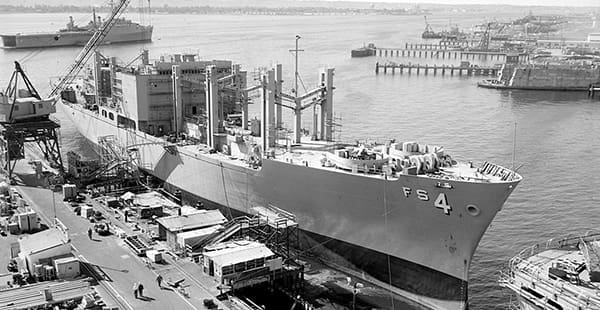NASSCO History
National Steel & Shipbuilding Company, or NASSCO, started as California Iron Works in San Diego, California, in 1905. It became National Iron Works in 1922 and expanded into shipbuilding in the early 1940s. Its acquisition of two nearby shipyards in 1947 increased its capabilities. In 1957, the company became NASSCO. By 1959, it had more than doubled its workforce from 750 to over 2,000.
Construction companies Morrison-Knudson, Henry J. Kaiser and F.E. Young bought NASSCO in 1960, with Morrison-Knudson becoming the sole owner in 1974. NASSCO continued growing throughout the 1970s. It expanded its facilities and saw peak employment of 6,508 workers in 1976. Morris-Knudson sold the company to its employees in 1989, which was the year of the NASSCO-built Exxon Valdez disaster. The accident prompted Congress to regulate how tankers had to be built.
The worker-owners sold the company to General Dynamics in 1998. It has since expanded with three partner shipyards on both coasts. It remains the only full-service shipyard on the West Coast.
NASSCO History at a Glance
- Other Names: California Iron Works, National Iron Works
- Location: San Diego, California
- Owner(s): Employees, F. E. Young, General Dynamics, Henry J. Kaiser, Morrison-Knudson
- Years of Operation: 1905 – Present
- Wartime Operations: World War II, Vietnam War, Gulf War, Iraq War
- Size of Shipyards: 86 acres of land and 47 acres of water
- Noteworthy Ships: Callaghan II, Cleveland III
- Types of Ships Built/Serviced: Barges, cargo passenger ships, combat support ships, containerships, crude carriers, deck barges, destroyer tenders, ferries, fleet oilers, hospital ships, landing ships, large tugs, minesweepers, mobile bases, product carriers, sealifts, shrimp boats, small tugs, torpedo retrievers, trailerships, tugs, tuna seiners
Asbestos was used to insulate hulls, pipes and boilers on ships for many years. It also provided heat insulation and fireproofing in shipyards themselves. Many shipyard workers exposed to asbestos have since developed asbestos diseases.
Notable Ships Built and Repaired
NASSCO has built and repaired hundreds of ships, including many for the U.S. Navy. The following two ships were both repaired by NASSCO, had long military careers and were integral to many missions.
USS Cleveland III (LPD-7)
This amphibious warfare ship was laid down in 1964 and launched in 1966. It traveled to Vietnam in 1967 and served in the Vietnam War on and off from 1967 to 1973. It received repairs at NASSCO from 1968 to 1969. After the war, it largely served as a transport and for training exercises.
In later years, Cleveland III supported various operations around the globe. Its missions included:
- Seizing over 11,000 pounds of cocaine off the coast of Panama in 1993
- Providing humanitarian aid after the Rwandan genocide in 1994
- Minesweeping in Operation Iraqi Freedom after 9/11
NASSCO repaired Cleveland III again in 2006. The ship was finally decommissioned in 2011, having received many awards.
The Navy mandated asbestos use on ships for decades. Cleveland III was built and first repaired at NASSCO during these years. It likely contained asbestos then and well after the Navy discontinued asbestos use. Since the ship was so active for so long, transporting people around the world, many veterans may have been exposed to asbestos.
USS Callaghan II (DDG-994)
This destroyer was laid down in 1978 and launched in 1979. Callaghan II never saw battle, but it participated in patrols, training, rescue missions and more worldwide. It earned the Humanitarian Service Medal for rescuing 283 Vietnamese refugees from the South China Sea in 1983. In 1987, it was stationed in the Persian Gulf amid fighting between Iraq and Iran. It helped safeguard commercial shipping in the area.
It was updated at NASSCO in 1994 and again in 1996. Just before the second visit, Callaghan II went to the Strait of Taiwan. Its presence helped ensure Taiwan’s first democratic elections, which passed peacefully. The ship briefly performed counter-drug patrols in Central America in 1997. In 2003, the Navy sold the ship to the Republic of China Navy. It sailed to Taiwan in 2005.
Callaghan II was built when the Navy was slowing its asbestos use. But some ships were still built with asbestos into the 1980s. Given its many travels around the world and many decades of service, many veterans and shipyard workers may have been exposed to the mineral.
Resources for Mesothelioma Patients
Asbestos at NASSCO
For decades, asbestos was widely used on ships and in shipyards like NASSCO. The mineral was popular in construction because of its properties. Asbestos is naturally strong and resistant to heat and fire. It insulated engine and boiler rooms, pipes and more on ships. It also appeared in machinery parts, bulkhead panels, decking and floor tiles and cement. Asbestos provided fireproofing and insulation in shipyards themselves, too.
Asbestos Exposure at NASSCO
As a result of its widespread use, many occupations were at risk of asbestos exposure at NASSCO. Workers who had to install, repair or remove asbestos insulation were at increased risk. But even those who worked around it, like Navy veterans, were at risk, too.
Occupations that had a risk of asbestos exposure at NASSCO include:
- Boiler workers
- Electricians
- Foundry workers
- Insulators
- Joiners
- Machinists
- Masons
- Mechanics
- Molders
- Painters
- Pipefitters
- Sheet metal fabricators
- Shipfitters
- Shipwrights
- Steamfitters
- Toolmakers
- Track workers
- Veterans
- Welders
- Wharf builders
- Woodworkers
Many shipyard workers exposed to asbestos have since developed related diseases like mesothelioma.
Asbestos Lawsuits and Settlements for NASSCO
Asbestos victims have several avenues to seek compensation. One is to file lawsuits against responsible companies. A mesothelioma lawsuit can compensate asbestos victims for medical bills, lost wages and more. Successful lawsuits may end in verdicts or settlements.
For example, A 75-year-old Marine Corps veteran worked at NASSCO as a shipfitter, crew leader and general foreman from the early 1960’s to the mid – 1970’s. He was exposed to asbestos while on the job and developed mesothelioma. A lawsuit was filed on his behalf against several companies that supplied asbestos products to the shipyard. Settlements totaled $4.2 million.
A mesothelioma lawyer can help you explore your legal options and pursue the best compensation route for your case. Besides lawsuits, they can also help with Veterans Affairs claims and asbestos trust fund claims.
Asbestos Trusts Associated With NASSCO
NASSCO does not have its own asbestos trust fund. But workers may be eligible to make claims against companies that supplied NASSCO with asbestos products.
Asbestos Trust Funds and Eligible Years of Employment
The following companies provided asbestos products to NASSCO. After exposing innocent people to asbestos and facing many asbestos lawsuits, these companies filed for bankruptcy and created trust funds to pay victims. If an individual worked at NASSCO and developed a disease such as mesothelioma, they may be able to file one or more claims against these companies’ trusts.
| Asbestos Company Name | Eligibility Start Date | Eligibility End Date |
|---|---|---|
| A.P. Green | 1/1/1963 | |
| Babcock & Wilcox | 12/31/1982 | |
| Combustion Engineering | 12/31/1982 | |
| Eagle-Picher | ||
| Fibreboard | 1/1/1957 | 12/31/1982 |
| Flexitallic Gasket | 1/1/1969 | 12/31/1982 |
| Harbison-Walker Refractories Company | 9/19/1974 | 12/31/1976 |
| J.T. Thorpe | 7/1/1952 | 7/31/1952 |
| Kaiser Aluminum | 1/1/1972 | 12/31/1982 |
| Keene | 1/1/1946 | 12/31/1982 |
| North American Refractories | 1/1/1968 | 3/31/1972 |
| Owens-Corning | 1/1/1952 | 12/31/1982 |
| Pittsburgh Corning | 7/1/1962 | |
| Thorpe Insulation | 1/1/1958 | 12/31/1979 |
| United States Gypsum | 1/1/1963 | 1/2/1968 |









